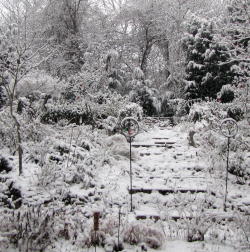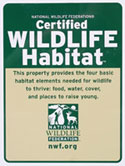
Since winter is a’comin’, it seems the perfect time to talk about how to make your garden pleasing in the cold seasons. This has been a topic of study here in the Fairegarden for many years. The house renovations have centered around providing the widest views possible of the garden, with seating arranged to be able to look out from different rooms and appreciate what we and nature have wrought. That is all fine and dandy during spring and summer, even the fall fantasia has much to offer. Then the color drains away with the warmth as the sun tilts away from this mortal coil. This is a large topic that will require several posts to fully cover. This is part one, about the plants that remain colorful here in our zone 7a garden. Large evergreens such as pine, cedar and hemlock, large shrubs such as arborvitae, chamaecyparis and hollies are not the focus today, although those are certainly helpful to add some color besides the brown and grey of the deciduous. Look around your neighborhood for ideas of what conifers and broad leaf evergreens are attractive to you and will grow in your area.

Today we will zoom in a little to the small shrubs and perennials that decorate the landscape, the accessories to the big boys. Let us zoom some more to exclude the greens, although green is a very important color in our world. But the term evergreen refers not just to greens but includes some more contrasting shades such as blue/silver, red/copper and yellow/gold. Note that these are the primary colors on the color wheel, blue, red and yellow, from whence all other colors arise. They please the eye, grab the retina to shout “Look at me!”. If you want the monotone calmness of a sea of green, read no farther.
Alphabetically to offend no color, we start with blue/silver. I include the metallic shades because of the organic blend of plant and mineral, let’s leave the animal out of it for now. Lamb’s Ear, Stachys byzantinus was one of the first plants used in our first real garden. The offspring were toddlers then and enjoyed the velvety surface of the glaucous leaves. Others with similar coloration are the various Dianthus ssp. They form eversilver mats of spikes with the bonus of many shades of pinky flowers in spring. Tricky in our climate but worth the trouble to keep replanting are Lavender and Santolina.
Alphabetically next comes the red/copper.
The breeders have done wonders for the gardeners looking for four seasons of beauty with the Heuchera family. The breeders at the Fairegarden, the pollinators, have also been buzzy, creating many seedlings including one that blew into the trough planter. Until this breakthrough in producing the reddish foliage color, all chance seedlings here have been shades of green. It has been named H. ‘Faire Piecrust’.
Some are changlings, green in summer turning to crimson and clover, oops make that purple with copper highlights in the winter. Reaching nearly thug-like status, having seeded in every crack and crevice is the Euphorbia dulcis ‘Chameleon’. Hardy Geranium sanguineum is another turncoat that becomes brilliant in winter. Certain sedums also rise to fulfill the destiny of their names, like S. ‘Dragon’s Blood’.
Alphabetically last of the group is the color that most attracts the eye, yellow/gold. Creeping jenny, Lysimachia nummularia ‘Aurea’, various Carex ssp. , ivies, more sedums, variegated Yuccas, among others offer the light and bright tints that help warm a wintery scene. Until the brilliantly yellow daffodils begin the growing season all over again.
This is enough for now. So get your pencils and paper and make some lists for your own four seasons of color. Visit your local nurseries, check out Arboretums, public gardens or your neighborhood plantings for ideas. Magazines, blogs and websites are good resources for lists of plants that will work in your climate. There is no reason to stare at brown and grey during those dreary cold months. Unless you live with heavy snow cover all winter, then, never mind.
Other posts in the How To Have Winter Interest series can be seen below in addition they are included in the category How To list on the sidebar:
How To Have Winter Interest-Garden Grassses
How To Have Winter Interest-Seeing Green
How To Have Winter Interest-Shrubs Small And Large
How To Have Winter Interest-The Big Guys
How To Have Winter Interest-Hardscape
For other How To posts written by Fairegarden, look for How To on the sidebar page listing or click here.
Frances




















Great post. I often suggest plant form for winter gardens here in the Falls. Your suggestion of color is wonderful for people in your zone and higher or with light snowfall. The plants suggested can endure light snowfall if it warms up again. Our color is limited pretty much by berries, bark and plants not removed in Fall. White is often what we get to see. I am sure your posts are going to be really good, this one being a great teaser of those to come.
My carex does stay green until about early March, then the March winds dry it out to brown. I will maybe get some photos of the blades popping out from the snow.
You are right, that is a tall order. Our main problem with many plants, is like yours. Without a snow covering for the whole winter, plants get dry, but then the snows come later and many, like lambs ears turn to mush in wet, poorly drained clay soils. Lavender, Coralbells, and dianthus just disappear, leaves that is, then rise to the occasion next spring. Hopefully that is. Wet soil can take out our lavender. Coralbelles sometimes have a hard time returning to their full splendor, shrinking as the years pass. Dianthus is usually very reliable. I am looking forward to your next posts. I like seeing how the same plants react in different climates and growing conditions. Even a different county here in Western New York has vastly different growing conditions.
What a great idea this post is as I have never given a lot of thought to winter plants. I have a few you mentioned but will try to have more now that I have seen yours. Can that
Yucca color guard take some snow? It looks like it might be to delicate.
Oh, it’s like candy for my soul =) I love the plants that keeps there colour all year long, and specially Heucheras. I’ve planted a lot of them so we can see them from inside (who want’s to go out in the cold wind to take a look?) Unfortunately we’ve only got one window facing the garden so we can’t see that much. But I hope to get a conservatory?(I guess that it’s where you sit in the lazyboy?) on the back of our house soon. Then we’ll be abel to see so much more of the garden during all seasons. I loved that variegated Yucca, I’ll have to see if I can find that at the nursery. The green variety like it in our garden so I bet it will work as well. Kram gittan
I did just add a yucca which will stick up through the snow for interest here. Love the heucheras but they are usually bedraggled and buried. The grasses are a must for winter interest here and also the seed heads of ‘Autumn Joy’. All good selections here. Must add more…
You have some very good ideas here Frances. Silver Scrolls are perfect for a Goddess.
Like Donna, late fall is about the latest we will see these foliage combinations, although I like to take a walk when we have a thaw to see what still looks good. Heucheras are usually flattened but still showy. Foxglove leaves often look good. Have you tried bergenia for winter interest? I only have one plant, but it turns a stunning red in cold weather that lasts until mud season.
I have so many lists from your blog! I’m still filling my new terrace garden and hope to make it relatively maintenance free. Since I’m replacing English Evil Ivy, I still want to keep it colorful in the winter. I’ve got a couple xmas ferns out there now and will be adding the euphoribia, carex and heuchera. Maybe even dianthus and creeping jenny (I didn’t know they’d survive winter here!) So many ideas!
I’ve just found you and I am enjoying reading your posts and looking at all the wonderful pictures! We live on a mountain side, with hungry deer and I am about to give up on planting. It’s very shady with large old oaks so we have an abundance of hosta, ferns, grasses and evergreens. The deer nibble on everything, our evergreens were bare bones last spring. I love the textures and colors in this post. Maybe I will learn something going through your blog that might help us with this ongoing problem.
Some years we live with snow most of the winter, which is actually better for our plants. Then, there are years when our plantings are exposed throughout the winter season. We will wait to see what colors survive.
Eileen
I don’t often think I have such a variety, but a friend visited the other day… and during her visit she collected a (great!) variety of leaves… all shades and sizes and shapes. And I thought to myself, hmmmm. It IS very diverse and pretty out there! 🙂
Sometimes it takes looking through another’s eyes….
Nice post, Frances! (Is Gardening not an ever evolving process?!)
I always learn so much from you Frances, and this post is no exception. The ‘Faire Piecrust’ and the Hedera are my faves! Such beautiful photos! I am 6a, but I am going to try some of your suggestions anyway, and see how they do 🙂
Sorry if this sounds like a teacher’s comment on an essay. That is my life right now, and they say one should build on one’s strengths. 😉 So here goes: Succinct, highly informative and written in an engaging style. Well done! A++ (Blotanical 4H rating!)
You have some good looking plants.
The Heuchera in the hypertufa planter looks great. Now I have to try that !!
Hi Frances. I love the way so many perennials add a new dimension to the garden at this time of year. Your euphorbia may be a bit of a thug, but it certainly earns its place! I don’t like all heuchera, the coral coloured ones leave me cold, but I adore the silvery tinges to e.g. ‘Sugar Frosting’, and always plant ‘Palace Purple’ for reliable colour through the winter. Good to be reminded that its not all about shrubs and trees when planning for year-round interest.
What a great post. So useful and inspiring. Ever since visiting other gardens this summer I’ve decided I must have a yucca or two. Of course in my climate the garden can be buried under a couple of feet of snow for most of the winter. Then I just enjoy crystal white.
What a great post, Frances! I’ve been focusing on adding more fall color this year, as it seems I have been infatuated only with spring and summer up to now. But winter interest is something I’d like to add more of as well. When the ground is covered with snow, it’s nice to see some tall plants like the faded hydrangea blooms gracing the landscape. But when the snow melts, some touches of color besides brown would be nice.
And another reason that I am in South Florida! It’s said that we don’t have seasons here, although we do; subtle is the best description.
I admit though that design for winter color is much more challenging north of zone 10.
Great post indeed! Extending garden season into winter and garden views through big windows are two areas that I really like to learn more from other gardeners. (OK stop laughing. I know ‘garden in winter in Canada’ sounds silly, but I am not convinced that it is entirely hopeless. I do have a couple of heathers that turn nice red and some conifers that turn bright golden in winter.) Looking forward to your future post on the subject. Hope you will post some pictures looking through your windows next year.
Your photos are beautiful and even if we dont have your climate, we also have some of those plants here.
I always love the look of the big picture of fall but really appreciate the close up look of the plants right next to our noses. Lovely.
Pingback: The Challenge Of Winter Interest-Work Not Luck « Fairegarden
Pingback: Time To Cut « Fairegarden
Pingback: Looking Through (Ever)Green Colored Glasses « Fairegarden